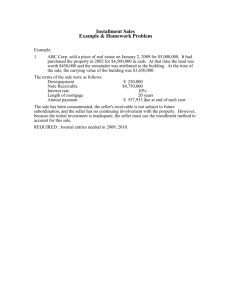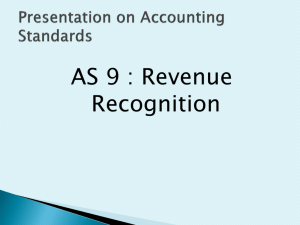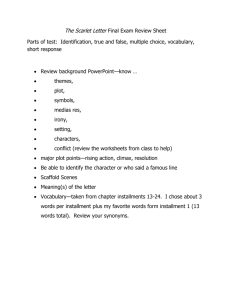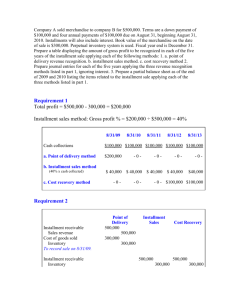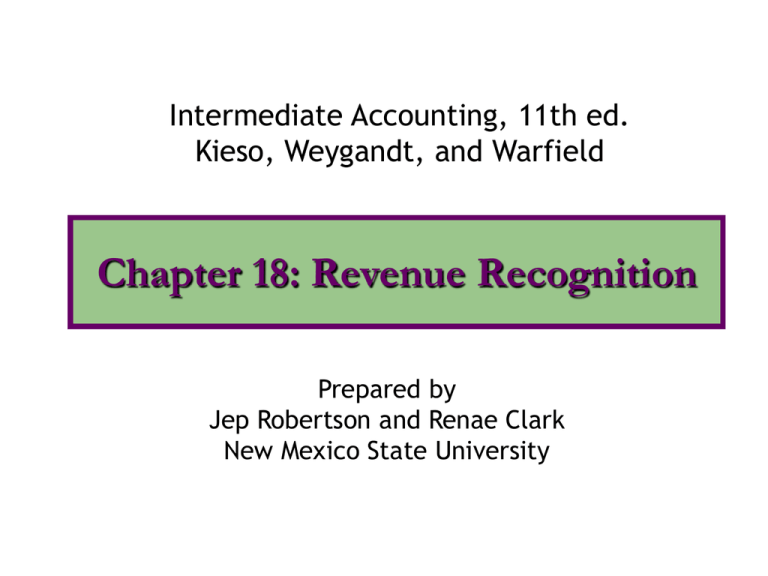
Intermediate Accounting, 11th ed.
Kieso, Weygandt, and Warfield
Chapter 18: Revenue Recognition
Prepared by
Jep Robertson and Renae Clark
New Mexico State University
Chapter 18: Revenue Recognition
After studying this chapter, you should
be able to:
1. Apply the revenue recognition principle.
2. Describe accounting issues involved with
revenue recognition at point of sale.
3. Apply the percentage-of-completion
method for long-term contracts.
4. Apply the completed-contract method
for long-term contracts.
Chapter 18: Revenue Recognition
5. Identify the proper accounting for
losses on long-term contracts.
6. Describe the installment-sales
method of accounting.
7. Explain the cost recovery method of
accounting.
Guidelines for Revenue
Recognition
The revenue recognition principle provides
that revenue is recognized:
• when it is earned, and
• when it is realized or realizable
Revenue is earned when the earnings process
is substantially complete.
Revenue is realized when goods and services
are exchanged for cash or claims to cash.
Revenue is realizable when assets received
are convertible into a known amount of
cash.
Four Types of Revenue
Transactions
• Revenue from selling products is recognized
at the date of sale (date of delivery).
• Revenue from services is recognized when
services are performed and are billable.
• Revenue from the use of enterprise’s assets
by others is recognized as time passes or as
the assets are used up.
• Revenue from disposal of assets (other than
inventory) is recognized at the point of sale
as gain or loss.
Revenue Recognition Classified by
Nature of Transaction
Revenue Recognition at Point of
Sale
Revenues from manufacturing and
selling are commonly recognized at
point of sale.
Exceptions:
1. Sales with buyback agreements
2. Sales when right of return exists (high rates
that are not reliably estimable)
3. Trade loading and channel stuffing
Revenue Recognition Before
Delivery
Revenue may be recognized before
delivery under certain circumstances.
• Long-term construction contracts are a
notable example
Two methods are available:
• The percentage-of-completion method, and
• The completed contract method
Revenue Recognition Before
Delivery
Long-Term Construction
Accounting Methods
Percentage-of-Completion
Method
1) Terms of contract must
be certain, enforceable.
2) Certainty of performance
by both parties
3) Estimates of completion
can be made reliably
Completed Contract
Method
1) To be used only when
the percentage method is
inapplicable [uncertain]
2) For short-term contracts
Percentage-of-Completion: Steps
1
Costs incurred to date
= Percent complete
Most recent estimated total costs
2 Estimated total revenue x Percent complete
= Revenue to be recognized to date
3 Total revenue to be recognized to date less Revenue
recognized in PRIOR periods = Current period revenue
4 Current Period Revenue less current costs = Gross profit
Percentage-of-Completion: Entries
• Cost of construction:
Construction in process (CIP)
Materials, cash, payables, etc.
• Progress billings:
Accounts receivable
Billings on CIP
• Collections:
Cash
Accounts receivable
Percentage-of-Completion: Entries
• To recognize revenue and gross profit:
Construction in process (gross profit)
Construction expenses
Revenue
• To record completion of project:
Billings on CIP
Construction in process
Percentage-of-Completion:
Example
Data: Contract price: $4,500,000
Start date:
July, 2003
Balance sheet date:
Given:
Estimated cost: $4,000,000
Finish: October, 2005
Dec. 31
2003
Costs to date
$1,000,000
Estimated costs to complete $3,000,000
Progress Billings during year
$900,000
Cash collected during year
$750,000
2004
$2,916,000
$1,134,000
$2,400,000
$1,750,000
2005
$4,050,000
$
-0$1,200,000
$2,000,000
What is the percent complete, revenue and gross
profit recognized each year?
Percentage-of-Completion:
Example
2003
2004
2005
% complete
to-date
1,000,000 = 25% 2,916,000= 72%
4,000,000
4,050,000
100 %
Revenue
recognized
4,500,000 * 25%
= 1,125,000
4,500,000 * 72% 4,500,000
less 1,125,000 less 3,240,000
= 2,115,000
= 1,260,000
Gross Profit
recognized
1,125,000 less
1,000,000
= 125,000
2,115,000 less
1,916,000
= 199,000
1,260,000
less 1,134,000
= 126,000
Recognizing Current & Overall
Losses on Long-Term Contracts
A long-term contract may produce:
•
•
either an interim loss and an overall profit,
or an overall loss for the project
Under the percentage-of-completion
method, losses in any case are immediately
recognized.
Under the completed contract method,
losses are recognized immediately only when
overall losses are indicated.
Recognizing Current & Overall
Losses on Long-Term Contracts
Current Loss on
an otherwise
overall profitable
contract
Loss on an
overall unprofitable
contract
Percentage Method:
Recognize loss currently.
Completed method:
No adjustment needed.
Percentage Method:
Recognize entire loss now.
Completed method:
Recognize loss currently.
Revenue Recognition After
Delivery
Revenue recognition is deferred when
collection of sales price is not
reasonably assured and no reliable
estimates can be made.
The two methods that are used are:
• the installment sales method
• the cost recovery method
If cash is received prior to delivery, the
method used is the deposit method.
The Installment Sales Method
• This method emphasizes income recognition
in periods of collection rather than at point
of sale.
• Title does not pass to the buyer until all cash
payments have been made to the seller.
• Both sales and cost of sales are deferred to
the periods of collection.
• Other expenses, selling and administrative,
are not deferred.
The Installment Sales Method:
Issues
• Installment sales must be kept separate
• Gross profit on installment sales must be
determinable
• The amount of cash collected from
installment accounts must be known
• The cash collected from current years’ and
prior years’ accounts must be known
• Provision must be made for the carry forward
of each year’s deferred gross profit
The Installment Sales Method:
Steps
• For installment sales in
any year
• For installment sales
made in prior years
(realized gross profit)
• Determine rate of gross
profit on installment
sales
• Apply this rate to cash
collections of current
year’s installment sales
to yield realized gross
profit
• The gross profit not
realized is deferred
• Apply the relevant rate
to cash collections of
prior year’s installment
sales
The Installment Sales Method:
Example
Given:
2003
Installment sales $200,000
Cost of sales
$150,000
Gross Profit
$ 50,000
Cash received in:
from 2003 sales $ 60,000
from 2004 sales $ -0from 2005 sales $ -0-
2004
2005
$250,000
$190,000
$ 60,000
$240,000
$168,000
$ 72,000
$ 100,000
$ 100,000
$
-0-
$ 40,000
$125,000
$ 80,000
Determine the realized and deferred gross profit.
The Installment Sales Method:
Example
Given:
Installment sales
Gross Profit
Gross profit rate
2003
$200,000
$ 50,000
25%
2004
2005
$250,000 $240,000
$ 60,000 $ 72,000
24%
30%
See next slide for realized and deferred
gross profit
The Installment Sales Method:
Example
2003
2004
2005
Gross profit rate
25%
24%
30%
Realized Gross Profit:
Gross profit deferred
From 2003 sales:
Realized in
$ 15,000
$ 25,000 $ 10,000
From 2004 sales:
deferred
Realized in:
$ -0$ 24,000 $ 30,000
From 2005 sales:
Realized in:
$ -0$
-0$ 24,000
The Installment Sales Method:
Partial Journal Entries (2003) for
Gross Profit
Installment Sales
200,000
Cost of Sales
150,000
Deferred Gross Profit, 2003
50,000
(To close 2003 accounts)
Deferred Gross Profit, 2003
15,000
Realized Gross Profit
15,000
(Realized: $60,000 x 25%)
Realized Gross Profit
15,000
Income Summary
15,000
(To close to Income Summary)
The Cost Recovery Method
Seller recognizes no profit until cash
payments by buyer exceed seller’s cost of
merchandise.
After recovering all costs, seller includes
additional cash collections in income.
This method is to be used where there is no
reasonable basis for estimating collectibility
as in franchises and real estate.
The income statement reports the amount of
gross profit recognized and the amount
deferred.
The Deposit Method
• Seller receives cash from buyer before
transfer of goods or performance.
• The seller has no claim against the
purchaser.
• There is insufficient transfer of risks to
buyer to warrant recording a sale by seller.
• In the case of such incomplete transactions,
the deposit method is used.
• The deposit method thus defers sale
recognition until a sale has occurred for
accounting purposes.
COPYRIGHT
Copyright © 2004 John Wiley & Sons, Inc. All rights reserved.
Reproduction or translation of this work beyond that permitted
in Section 117 of the 1976 United States Copyright Act without
the express written permission of the copyright owner is
unlawful. Request for further information should be addressed
to the Permissions Department, John Wiley & Sons, Inc. The
purchaser may make back-up copies for his/her own use only
and not for distribution or resale. The Publisher assumes no
responsibility for errors, omissions, or damages, caused by the
use of these programs or from the use of the information
contained herein.

